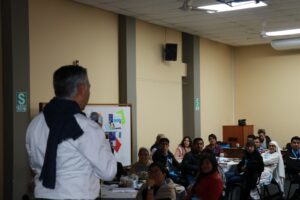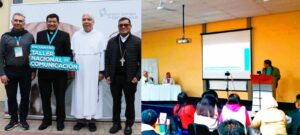We all live in a network. Interconnected. In the digital ecosystem, journalists and communicators are eager to be heard. How can they achieve this? This is the new challenge that beckons YouTubers, Tictakers, Instagrammers, and all those who identify as “influencers.”
Summoned to devote time to “listen,” journalists and communicators intertwined their experiences at the national communications workshop meeting, organized by the Episcopal commission for the media of the Peruvian Episcopal Conference. All in pursuit of reaching those still residing in digital peripheries, in lands devoid of a mission.
Why is it crucial to dedicate time to “listen”?
Following the synod table on synodality in Rome in October 2023, it was determined that the dicastery of communications must support the process of “listening” to enable a Church on the move. In the wake of the synod, three simultaneous actions unfolded: devoting time to listening, playing the role of a Samaritan to embrace the wounded, and acting with creativity and courage.
How can we connect with those who inhabit social networks? Can we venture to engage with them in the digital realm? Undoubtedly, the presence of “influencers” at the recent synod underscored the concerns harvested from the digital ecosystem. A total of 244 influencers enabled the amplification of 150 thousand proposals from those seeking to be heard, congregating an additional 20 million participants for the synod.
This is how “The Church: listens to you” orchestrated the synod in the digital biosphere—an environment ripe for engagement. Faced with cultural shifts, Oscar Elizalde, the communications director of the Latin American Episcopal Council CELAM, underscored the missionary essence of this endeavor to connect with others, instilling a sense of urgency to integrate digital culture.


Oscar Elizalde, director of communications for CELAM, held the panel “From influencers to digital missionaries”
“Samaritanizing” digital communications
Amidst the challenges faced in Latin America—ranging from poverty and inequality to diverse political landscapes—there exists a cry and a necessity to hear the growing “digital biome” that influencers bring to the forefront. In the age of digital communication transformations, fostering consensus amidst these divergences to bridge gaps, as proposed in chapter 17 of the synod’s summary report, is paramount.


This is where the imperative to “samaritanize” those who are still hurting or feeling marginalized arises. The goal is to offer a new perspective through communications, evangelizing these networks to adapt to individual realities and avoid merely “digitizing the pastoral” but rather establishing a “digital pastoral,” as elucidated during Elizalde’s discourse on the Church’s response to cultural shifts.
Communication experiences from Peru
For over six decades, Santa Rosa Radio and Television (SRRTV) has stood as Peru’s first Catholic radio station, as highlighted by the general director of this radio station, Fray Carlos Sánchez Ortiz, OP, during the panel “Communication in Peru: Experiences.”


Presentation of the panel “Communication in Peru”: Experiences by Fray Carlos Sánchez Ortiz, OP, general director of SRRTV. In the photo, accompanied by Monsignor Edison Farfán Córdova, OSA bishop of Chiclayo and president of the episcopal commission for the media of the CEP
The radio broadcasts from the Santo Domingo convent, serving as a contribution from the apostolate of the enclosure. The Dominican priest mentioned that they acquired it post-pandemic, initiating immediate efforts. Hence, pastoral work now extends to digital communication through streaming and the live YouTube channel, alongside the corresponding website www.santarosaradio.com.pe, and AM (1500 AM) and FM (105.1 FM) frequencies.
Since February 2023, they have expanded to six cable channels redistributing content locally on television. “Yet, our aim is to broaden our audience through social networks, addressing the digital sphere’s communication needs,” stated the Dominican priest.
Additionally, journalist Esther Núñez Balbín, the press head for SRRTV, is spearheading a “press laboratory” to advocate for a distinctive, ethical, responsible, and participatory journalism from the station, as demonstrated during the event.



